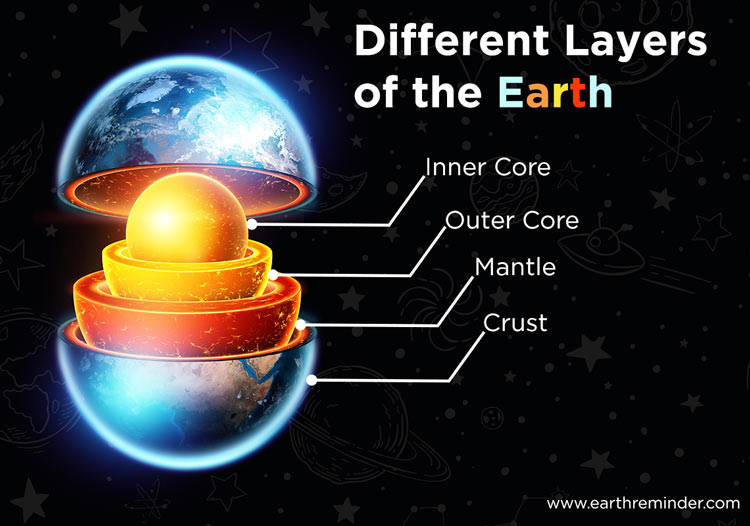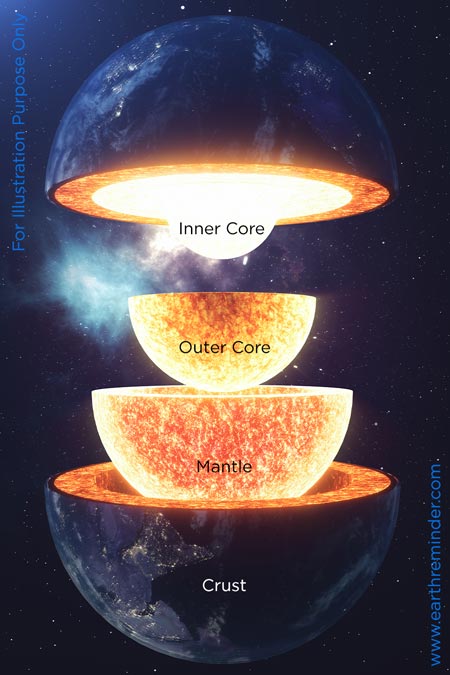What are the different layers of the earth?: Have you ever thought, how deep can we go down the soil? Isn’t it a thing to be curious about? Well, our earth is filled with unlimited mysteries. A very few of them are justified with concrete evidence, yet, there are lots and lots of things to know about our living place.
There is no lack of technical advancement, and researchers are working from every part of the universe. Still, we just have sand of knowledge on the seashore.
One of those mysteries includes the center of the earth. As we imagine our planet as a sphere, then it is possible that it might be hollow or solid. But, according to several studies and lots of calculations, it came to know that our earth is solid, and it has different layers down the soil.
These layers terminate at nearly 6,400 feet beneath the soil. We can even imagine this by cutting an onion. Like an onion, our earth has different layers, one after another.
All these layers are different in their density, temperature, and pressure, and it was found that the density level increases with an increase in distance.
Here in this article, we will understand all those questions, which makes us curious to know what is the makeup of our earth. So, Let’s dig deeper!
Table of Contents
How did scientists understand the makeup of the earth?
After knowing that our earth is like a solid ball having different layers inside, the first question that comes to mind is how scientists could find this fact without visiting there.
Yes, only our crust – the upper layer – is a portion that is visited and studied thoroughly. Besides, we have two more layers, namely, mantle and core. And no one has seen these two layers in their physical eyes (of course, we can imagine them according to their description given by researchers).
So, the answer here is Seismology. It is the study of earthquakes, and the elastic waves propagating through the earth and other planets. By monitoring some properties such as sound waves and seismic velocity, scientists come to know this subject deeply.
Besides other physical properties like temperature, and pressure, magnetic field and gravitational pool are also considered.
After a long-term study and calculation, it becomes clear that there are three primary layers of the earth, which are further differentiated as outer and inner.
It’s been a long time that researchers are studying and analyzing data to understand the interior of the earth thoroughly. If we go back to history, we will realize that it was assumed that earth was made up of tiny materials or colloid particles about 4.6 billion years ago.
Due to many factors and the development of gravitational pools, the huge mass of stacked particles forms a high thermal energy ball.
As time passed, the materials with higher density sank, and the low-density materials rose, forming the crust of our earth. Thus, it is said that the innermost layer, i.e., core, is made up of Iron and nickel like heavier metals. Furthermore, in this chapter, we will know deeply about all these layers constructing the earth’s interior.
Explaining Different Layers of the Earth
It is clear that our earth is made up of three different layers, such as; the crust, the mantle, and the core. However, these are called the compositional differentiation of the earth’s interior.
Instead, we can also explain the different layers of earth in terms of mechanical differentiation. According to mechanical division, our planet has layers such as the Lithosphere, Asthenosphere, mesosphere, and outer core.
The compositional division is based on the chemical separation of the layers along with the composition of each. However, mechanical separation is based on rigidity and strength.
Now, let’s understand some more details about the layers making the earth.
Mechanical Differentiation:
As we discussed, mechanical differentiation is quite different from compositional or chemical layers. Yet, we can discuss each of these two categories together by comparing one with another.
Now, let’s know a few features about each layer under this category.
Lithosphere
The lithosphere is the outermost layer of the earth, with a variety of thickness ranging from 70 km to 150 km; This is a highly rigid layer, which includes the crust and the top or outer mantle of the composition layers. This solid layer is called the sphere of rock.
Asthenosphere
The Asthenosphere comes after going deeper into the lithosphere. It starts from the lithosphere and extends about 350 km deep. The Asthenosphere lies within the mantle region, having a lower viscosity—the materials in this layer flow and ductile in nature.
Mesosphere
After the Asthenosphere, there is another layer included in the lower mantle. This region has a high viscosity, and the state of materials here is stiff plastic. Its depth ranges from 350 km to 2900 km.
Outer core
The layer comes next to the mesosphere, known as the outer core; This is part of the core region. This layer is liquid due to high temperature but low pressure. Here density is much higher than the upper layers. Its depth started from the end of the mesosphere to the central point of earth.
Compositional or Chemical Differentiation:
There are chemical layers between the compositional separation of the earth’s center. It is composed of three layers, as explained before. Now, let’s have a closer view.
The Crust
The crust is the topmost part of the earth. This layer is the thinnest among all the three layers. According to seismic studies, it is the lightest layer of the planet, having very little density. However, density differs based on the composition of the layer.
The crust can be divided into two types according to the thickness: the continental crust, which is thick and includes mountain ranges, and the oceanic crust with a narrow thickness.
Granite rock (Sodium potassium aluminum silicate) is the major component in the continental crust with a comparatively lower density of ~2.6g/cm3. However, the oceanic crust contains materials like Andesite and basalt (iron magnesium silicate igneous rock) with more density, i.e., ~3g/cm3.
The depth of the earth’s crust is from 5 km to 70 km; This is the region forming the entire surface of the planet. Moreover, this is the coolest but toughest part of the earth.
The Mantle
Inner to the outermost part, another layer, i.e., mantle remains, which is chemically separated from the crust and the core.
This is the layer of Aluminum and Silicate, having characteristics to flow but not exist as a liquid. Yes, this layer is a ductile, plastic layer having different viscosity at the top and the bottom.
This layer can also be distinguished into two layers, such as; the upper mantle and the lower mantle. The upper mantle begins at the end of the crust, which is called the Mohorovicic Discontinuity.
Its thickness is about 720 km, and its top part and bottom parts have a density of 3.4 and 4.4 g/cm3, respectively. This region is formed of materials like Peridotite, eclogite, olivine, spinel, garnet, pyroxene composing a low density and, some other materials like perovskite, oxides having relatively high density. The upper mantle region can easily flow under pressure (high ductile).
The lower mantle has a depth of 2171 km and is said to be the stiff plastic region due to the high viscosity and lower flow rate. This layer comprises metals such as Magnesium and silicon oxides, yet having density ranges between 4.4 to 5.6 g/cm3. The temperature of the lower mantle extends from 1900 K to 3000 K.
In this region, the molten rocks are formed and remain in the temperature near the melting point.
The Core
The innermost portion of the earth or its center is known as the core. R.D. Oldham, in 1906, had discovered the central part of the planet, which helps him explain the calculation given by Sir Isaac Newton for the density of the earth.
Shear waves and Compressional waves are the waves in Seismology that describe the state of a layer. And according to those records, the outer core is described as in a liquid form while the inner core is solid.
The study of several factors such as inertia, earthquake waves, rotation, and magnetic field dynamo theory explains that the core of the earth is primarily made up of Iron of about 90% and nickel, oxygen, or sulfur alloys.
The thickness of the upper core ranges from 2300 to 3400 Km. Here temperature started from 3000 k to about 5000 k. Two factors, such as temperature and pressure, determine the physical state.
Thus, due to high temperature but low pressure, this region exists in the liquid state. This region’s density remains 9.9 g/cm3 at the upper part and 12.2 g/cm3 below.
The lower core seems like a ball at the centre of the earth where the temperature ranges from 5000 K to 7000 K.
Although this region has a high temperature still, it exists as a solid ball, perhaps due to high pressure; This is the densest region, and the density extends from 12.8 g/cm3 to 13.1 g/cm3.
Studies suggest that the earth’s magnetic field is influenced by its core.
Conclusion of Various Layers of the Earth:
Our earth is not only a beautiful planet but exists as an infinite source of knowledge. With the advanced research on geology and earth science, we can get lots of information about the different earth layers.
Further, discoveries can also describe the complexity hidden in the deep earth, and there may be a day when we can see the layers with real eyes or as photographs.
What you are thinking about the topic, comment down below, and follow us for more useful information.

